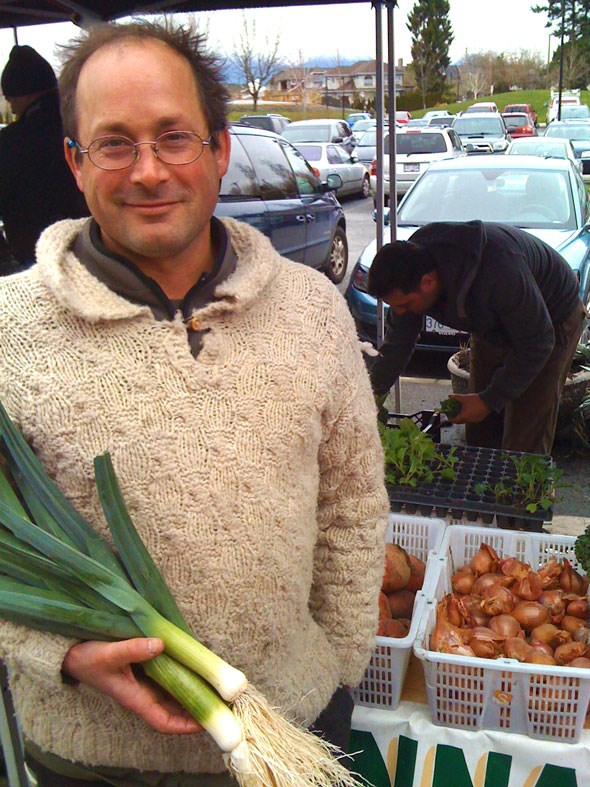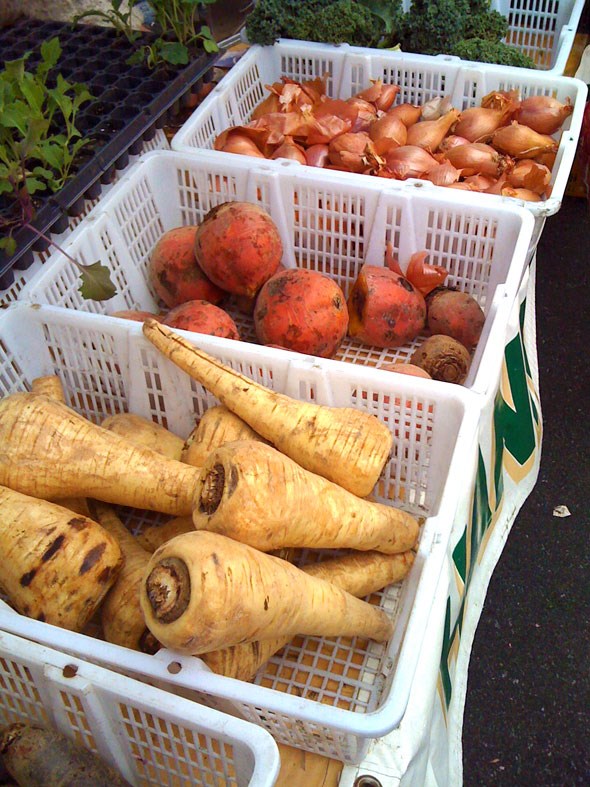| is about people who love fresh food at festive gatherings. With the initial goal in 1995 to create the fun and value of weekly Farmers Markets in urban settings, the Society and the Markets have become Â鶹´«Ă˝Ół»plazas of fun, discovery, and connecting. Each month V.I.A. introduces you to one of the fabulous Market vendors! |
Vendor Profile: Hannah Brook Farm
By Kim Peterson

On the last week of March, the farmer’s fields in the Fraser Valley look a lot like the rest of Greater Vancouver: soggy. It means that tractors idle, and seeds remain topside until spring sunshine brings firmer ground.
Despite all this, Paul Healey and his team were out, sowing 4,500 plants on Hannah Brook Farm just off the banks of the Fraser River. Excessive moisture won’t stop Healey from getting a head start every year, and it’s all because of a unique method of farming invented in Mesoamerica more than 500 years ago.
The Aztec city of Tenochtitlan (where Mexico City now sits) was built on swampy land, mostly unsuitable for traditional farming. To feed the massive population, farmers built up islands of soil called chinampas in shallow lakes or swamps, and cultivated the mounds while using the canals as the main source of water.
Healey’s modified the practice slightly, but the idea is the same. “Basically I have two or three hundred islands that are all different shapes. In between all those I have dug trenches and mounted beds on top of those trenches.”
Hannah Brook sits on a piece of land at the confluence of the Stave and Fraser Rivers in the town of Ruskin, between Maple Ridge and Mission. The property backs on to an estuary, and has 30 artesian springs, which consistently and naturally pump water into the trenches. Like a giant self-watering container.
About 25% of what grows on Hannah Brook is native plants that thrive without much coaxing. “The water is so mineral rich that the plants survive off the water as their fertilizer,” says Healey. Plus, he adds nitrogen to the soil by spreading decaying salmon, which are caught in the nearby jetty every year after travelling upstream to lay their eggs.
The downside of this is that invasive plants also find Hannah Brook hospitable. “The weeds go crazy,” says Healey. His response, of course, is to yank them out and compost.

This sounds like the sort of wisdom that’s been passed down through generations, but Healey’s been a farmer for about seven years. Before that, he was a public school teacher in Washington DC. He met Martin Rothe, a fruit farmer from Oliver, whose family pioneered the biodynamic method of farming. Rothe became his mentor, and Healey left teaching behind to cultivate a new career in Canada.
As so often is the case with non-industrial farmers, Healey shoulders a great deal of responsibility when it comes to Hannah Brook’s operation. “I do everything,” he says. But that’s not a complaint. Healey loves farming (his favourite part is turning a nice, clean bed by hand), and he’s also not the type to take a vacation. “I don’t want a break, it’s not in my personality.”
Hannah Brook’s signature salad mix is in high demand in many of Vancouver’s fine dining restaurants, including top spots like Cioppinos and La Quercia. Healey said he enjoys bringing new product to the table. “This year I’m growing a lot of really rare obscure seeds. Those products are making a lot of the fine dining chefs really happy,” he says.
For everyone else, he’s found a niche in leeks: apparently the best part is often tossed before these root veggies even make it to market. Keep it on the DL, but the roots are divine. “I’m eating them right now as I’m speaking to you and they’re the most delicious part of the plant,” he says.
Hannah Brook produce is in high demand, so if you want leek roots, be an early bird. The Winter Market at Nat Bailey Stadium runs Saturdays until April 28. Summer markets start up mid-May.


